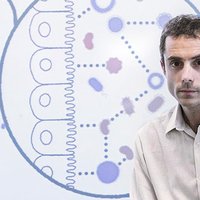“My parents came here from El Salvador in the late ’70s to escape from civil war. They worked 100-hour weeks to give me and my brother and sister the opportunity of a better life. Years later, we have all these opportunities that we couldn’t have dreamed of in El Salvador. I can’t think of any better motivator.
The first seeds of my interest in the brain were planted between junior high and high school, when my cousin went into labor. While under anesthesia during a C-section, she went into a coma that she’s been in ever since. The parts of her brain that are involved in producing consciousness and wakefulness were probably atrophied because they didn’t get enough oxygen for just a short period of time. It instantly hit me: all it takes are these little lumps of tissue in your brain to atrophy, and now everything that makes you you is evaporated.
Because the seemingly ephemeral stuff of cognition is based on the physical stuff of the brain, we can go in and manipulate it and see how something as complicated as memory works. When you are thinking of a memory, only a subset of brain cells are active, and those cells are specifically representing that memory. We can genetically modify neurons to produce a sensor that detects when brain cells are active and then installs an on-off switch in them. The switch is a protein that allows us to control the activity of a cell with light.
So now we can emit light and reactivate cells and see whether a mouse exhibits behaviors that show whether it is recalling a certain memory. We place the animal in a box where it gets mild foot shocks from the floor. Naturally, if we later put the mouse back in the box, it runs to a corner in fear—it sits there and freezes, crouching and monitoring. Next, we put the mouse in a completely different box—different smells, sights, floor texture. In this new box the mouse has no reason to be afraid. But when we shine a light to reactivate the cells involved in making that fear memory, the animal immediately goes into that defensive posture. We can also shine light and reactivate pleasurable memories, such as a male mouse’s memory of a female mouse.
In my second project, we tried to get a mouse to believe that it experienced something that it didn’t. We called it Project Inception. First, we label the brain cells that are involved in the memory of a chamber—environment A—where nothing bad happens. The next day we put the mouse in environment B, where it gets foot shocks, and we simultaneously shine a light to reactivate the memory of environment A. Then, when you put the mouse back in environment A, it displays freezing behavior. It is recalling falsely that it was shocked in environment A even though nothing happened there.
We are pushing this technology as far as possible. Perhaps we can alleviate post-traumatic stress disorder by erasing the underlying traumatic memory. Or perhaps we can treat certain types of depression by updating negative memories with positive emotions. Science fiction can often inform reality.”
—as told to Susan Young




